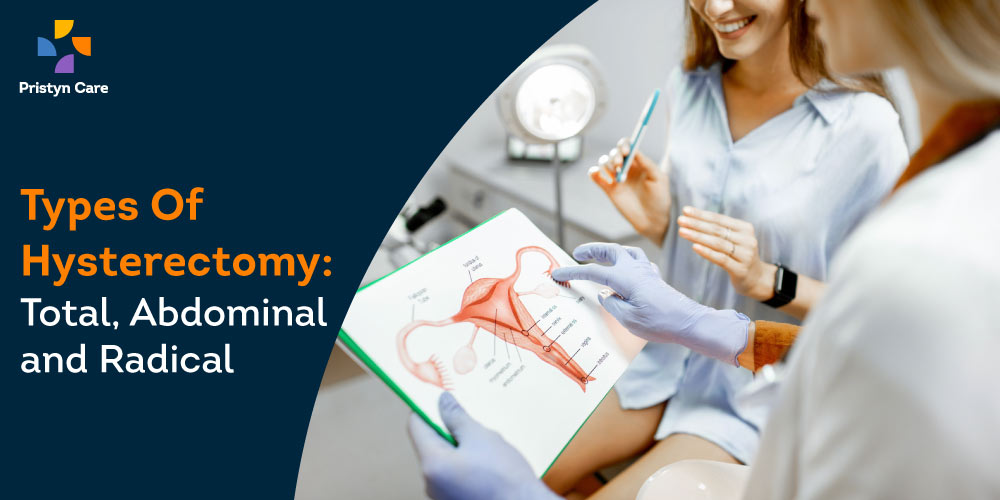
Hysterectomy is one of the most difficult surgical procedures to undergo. In some cases, some women experience having trouble recovering after the procedure, both emotionally as well as physically. Hence, it is of utmost importance that every standard of procedure is followed pertaining to the surgery, including the type of hysterectomy to consider.
Table of Contents
Types of Hysterectomy
The primary objective of a hysterectomy is to remove the uterus. There are two types of classification one can find about hysterectomy–
- On the basis of the organ removed along with the uterus
- On the basis of the technique used to remove the uterus
On the basis of the organ removed along with the uterus
The following are the common types of hysterectomy that the doctor generally prescribes depending on the underlying cause of undergoing the procedure.
Total hysterectomy
A total hysterectomy is the technique in which the doctor removes the entire uterus in addition to the cervix.
Partial hysterectomy
In this procedure, the doctor removes the uterus and leaves the cervix intact. In case the doctor detects the presence of cancerous cells around the cervix, they can choose to remove it too. Or else, the doctor recommends continuous regular screening of the cervix.
Hysterectomy with bilateral salpingo-oophorectomy
Doctors prescribe this type for curbing the spread of cancerous cells in the ovaries, uterus and fallopian tubes, extreme pelvic pain due to endometriosis, recurrent pelvic infections, etc. This type of hysterectomy involves removing the ovaries, fallopian tubes along with the uterus.
Radical hysterectomy
Radical hysterectomy is prescribed to patients who have been diagnosed with malignant cells in the uterine area. It involves the removal of the uterus, cervix, upper part of the vagina, surrounding tissues around the cervix and lymph nodes found in the pelvis.
Also Read:
On the basis of the technique used to remove the uterus
Abdominal hysterectomy
This type of hysterectomy is prescribed to those women who are obese, have a large uterus and has scar tissues due to previous open surgeries. This type of surgery allows much more flexibility to the doctors. During this procedure, the doctor makes a transverse incision in the abdomen just above the pubic area. Through this incision, the uterus and any other organ is removed. This technique is prescribed to patients whose ovaries as well as fallopian tubes are removed along with the uterus due to development of uterine fibroids, endometriosis, disease spreading around the pubic area or cancer.
Vaginal hysterectomy
Simply, it is the removal of the uterus through a cut or incision made in the vagina. The type of hysterectomy allows doctors to cure uterine prolapse. The biggest advantage of this technique is that the doctors make the incisions inside the vagina which means no visible scars form after the procedure. The whole recovery takes around 2 weeks to complete with this procedure.
The doctor first disconnects the uterus, ovaries, upper vagina and fallopian tubes. The surrounding blood vessels are carefully removed. After this, the doctor makes a long incision in the uterus. Using a specialized instrument called a morcellator, the uterus is removed slowly.
Laparoscopic hysterectomy
As the name suggests, this type of hysterectomy involves using special instruments such as a laparoscope to complete the procedure. The doctor makes incisions in the abdomen that are very small in size. Through this laparoscope, the gynaecologist is able to navigate freely and complete the procedure without any major complications. This is a minimally-invasive surgery (MIS) which means the cuts and incisions are of the smallest size. As it is minimally invasive in nature, this offers several benefits over other types.
Advantages of laparoscopic hysterectomy
With the advancement of technology, even in the health sector, several new techniques such as the use of the laparoscope have become quite popular around the globe. The high popularity of this type is primarily due to its unique features and associated benefits. Some of these are explained below-
- Lesser chances of any major mishap such as injury to other organs, internal jury, etc. minimizes considerably as the doctor maneuvers through the abdomen more accurately.
- As the cuts or incisions are small in size, the bleeding is much lesser.
- Chances of any major complications occurring during recovery is also less.
- Patient is able to recover within a week or two.
- The patient can resume work immediately within 24 hours of the procedure.
Also read: Laparoscopic surgery in times of COVID-19
Risks and complications of Hysterectomy
There is a high possibility of risks and complications occurring after hysterectomy, irrespective of the type one is undergoing. Similar to any other surgical procedure, the patient is likely to experience any one of the following complications or risks during the recovery-
- Infection around the wounds
- Constipation
- Excessive bleeding due to hemorrhage
- Unable to hold the urine temporarily
It is noteworthy that the above mentioned risks or complications are more likely to occur when the patient fails to follow the post-operative routine judiciously and throughout the recovery period. Also, these side effects are only temporary in nature and subsides with time.
Conclusion
To conclude, there are various types of hysterectomy available and the most appropriate one is prescribed to the patient after a thorough analysis and diagnosis of the underlying factor. Irrespective of the type of hysterectomy one has undergone, there is a high probability of some risks that can occur. In case you have been prescribed the procedure and thinking about where to get one, consider Pristyn Care.
Read more:







